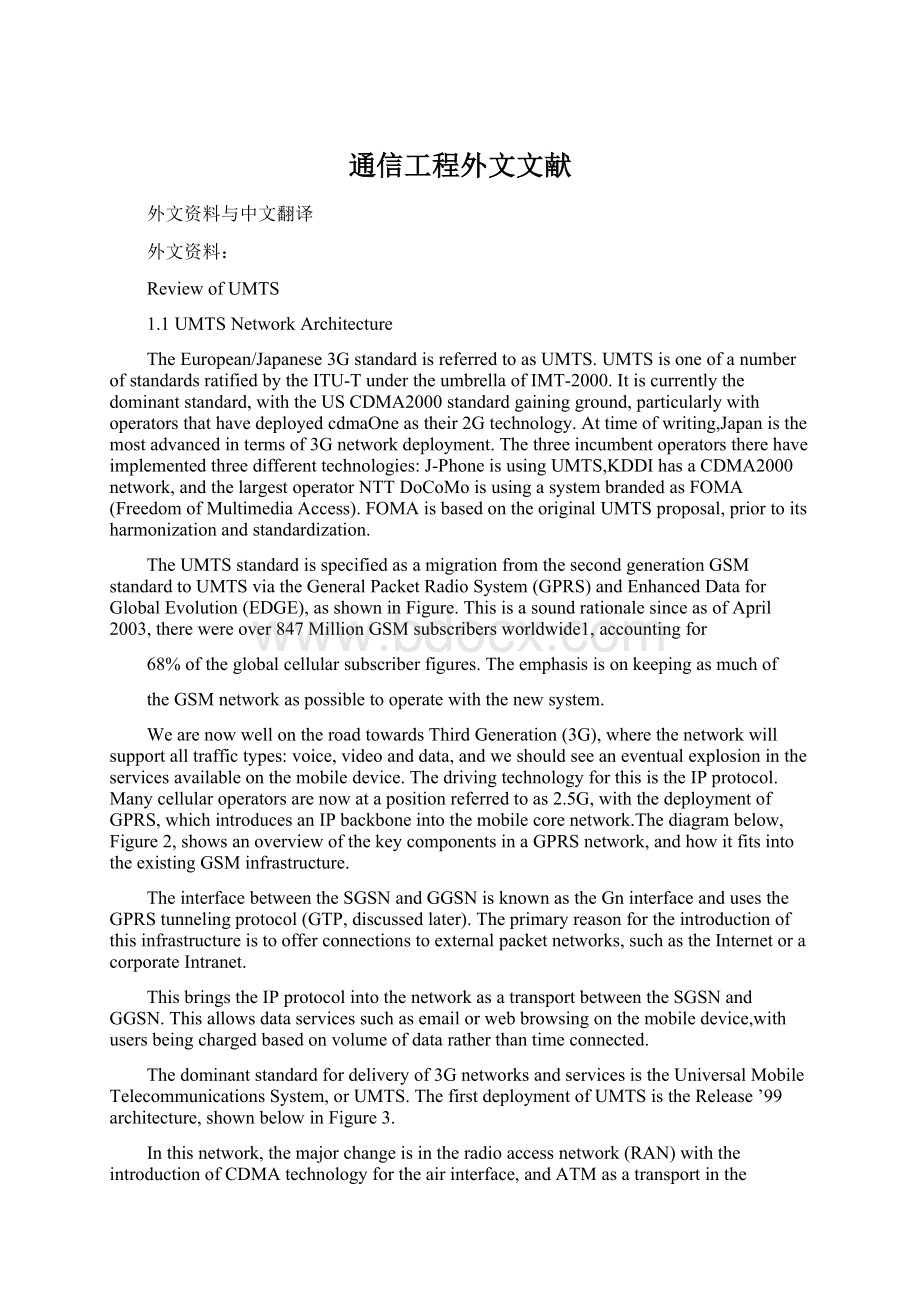 通信工程外文文献Word格式文档下载.docx
通信工程外文文献Word格式文档下载.docx
- 文档编号:18960708
- 上传时间:2023-01-02
- 格式:DOCX
- 页数:7
- 大小:24.32KB
通信工程外文文献Word格式文档下载.docx
《通信工程外文文献Word格式文档下载.docx》由会员分享,可在线阅读,更多相关《通信工程外文文献Word格式文档下载.docx(7页珍藏版)》请在冰豆网上搜索。

ReviewofUMTS
1.1UMTSNetworkArchitecture
TheEuropean/Japanese3GstandardisreferredtoasUMTS.UMTSisoneofanumberofstandardsratifiedbytheITU-TundertheumbrellaofIMT-2000.Itiscurrentlythedominantstandard,withtheUSCDMA2000standardgainingground,particularlywithoperatorsthathavedeployedcdmaOneastheir2Gtechnology.Attimeofwriting,Japanisthemostadvancedintermsof3Gnetworkdeployment.Thethreeincumbentoperatorstherehaveimplementedthreedifferenttechnologies:
J-PhoneisusingUMTS,KDDIhasaCDMA2000network,andthelargestoperatorNTTDoCoMoisusingasystembrandedasFOMA(FreedomofMultimediaAccess).FOMAisbasedontheoriginalUMTSproposal,priortoitsharmonizationandstandardization.
TheUMTSstandardisspecifiedasamigrationfromthesecondgenerationGSMstandardtoUMTSviatheGeneralPacketRadioSystem(GPRS)andEnhancedDataforGlobalEvolution(EDGE),asshowninFigure.ThisisasoundrationalesinceasofApril2003,therewereover847MillionGSMsubscribersworldwide1,accountingfor
68%oftheglobalcellularsubscriberfigures.Theemphasisisonkeepingasmuchof
theGSMnetworkaspossibletooperatewiththenewsystem.
WearenowwellontheroadtowardsThirdGeneration(3G),wherethenetworkwillsupportalltraffictypes:
voice,videoanddata,andweshouldseeaneventualexplosionintheservicesavailableonthemobiledevice.ThedrivingtechnologyforthisistheIPprotocol.Manycellularoperatorsarenowatapositionreferredtoas2.5G,withthedeploymentofGPRS,whichintroducesanIPbackboneintothemobilecorenetwork.Thediagrambelow,Figure2,showsanoverviewofthekeycomponentsinaGPRSnetwork,andhowitfitsintotheexistingGSMinfrastructure.
TheinterfacebetweentheSGSNandGGSNisknownastheGninterfaceandusestheGPRStunnelingprotocol(GTP,discussedlater).Theprimaryreasonfortheintroductionofthisinfrastructureistoofferconnectionstoexternalpacketnetworks,suchastheInternetoracorporateIntranet.
ThisbringstheIPprotocolintothenetworkasatransportbetweentheSGSNandGGSN.Thisallowsdataservicessuchasemailorwebbrowsingonthemobiledevice,withusersbeingchargedbasedonvolumeofdataratherthantimeconnected.
Thedominantstandardfordeliveryof3GnetworksandservicesistheUniversalMobileTelecommunicationsSystem,orUMTS.ThefirstdeploymentofUMTSistheRelease’99architecture,shownbelowinFigure3.
Inthisnetwork,themajorchangeisintheradioaccessnetwork(RAN)withtheintroductionofCDMAtechnologyfortheairinterface,andATMasatransportinthetransmissionpart.Thesechangeshavebeenintroducedprincipallytosupportthetransportofvoice,videoanddataservicesonthesamenetwork.Thecorenetworkremainsrelativelyunchanged,withprimarilysoftwareupgrades.However,theIPprotocolpushesfurtherintothenetworkwiththeRNCnowcommunicatingwiththe3GSGSNusingIP.
ThenextevolutionstepistheRelease4architecture,Figure4.Here,theGSMcoreisreplacedwithanIPnetworkinfrastructurebasedaroundVoiceoverIPtechnology.
TheMSCevolvesintotwoseparatecomponents:
aMediaGateway(MGW)andanMSCServer(MSS).Thisessentiallybreaksaparttherolesofconnectionandconnectioncontrol.AnMSScanhandlemultipleMGWs,makingthenetworkmorescaleable.
SincetherearenowanumberofIPcloudsinthe3Gnetwork,itmakessensetomergethesetogetherintooneIPorIP/ATMbackbone(itislikelybothoptionswillbeavailabletooperators.)ThisextendsIPrightacrossthewholenetwork,allthewaytotheBTS.ThisisreferredtoastheAll-IPnetwork,ortheRelease5architecture,asshowninFigure5.TheHLR/VLR/EIRaregeneralisedandreferredtoastheHLRSubsystem(HSS).
Nowthelastremnantsoftraditionaltelecommunicationsswitchingareremoved,leavinganetworkoperatingcompletelyontheIPprotocol,andgeneralisedforthetransportofmanyservicetypes.Real-timeservicesaresupportedthroughtheintroductionofanewnetworkdomain,theIPMultimediaSubsystem(IMS).
Currentlythe3GPPareworkingonRelease6,whichpurportstocoverallaspectsnotaddressedinfrozenreleases.SomecallUMTSRelease64GanditincludessuchissuesasinterworkingofhotspotradioaccesstechnologiessuchaswirelessLAN.
1.2UMTSFDDandTDD
LikeanyCDMAsystem,UMTSneedsawidefrequencybandinwhichtooperatetoeffectivelyspreadsignals.Thedefiningcharacteristicofthesystemisthechiprate,whereachipisthewidthofonesymboloftheCDMAcode.UMTSusesachiprateof3.84Mchips/sandthisconvertstoarequiredspectrumcarrierof5MHzwide.Sincethisiswiderthanthe1.25MHzneededfortheexistingcdmaOnesystem,theUMTSairinterfaceistermed‘wideband’CDMA.
ThereareactuallytworadiotechnologiesundertheUMTSumbrella:
UMTSFDDandTDD.FDDstandsforFrequencyDivisionDuplex,andlikeGSM,separatestrafficintheuplinkanddownlinkbyplacingthematdifferentfrequencychannels.Thereforeanoperatormusthaveapairoffrequenciesallocatedtoallowthemtorunanetwork,hencetheterm‘pairedspectrum’.TDDorTimeDivisionDuplexrequiresonlyonefrequencychannel,anduplinkanddownlinktrafficareseparatedbysendingthematdifferenttimes.TheITU-Tspectrumusage,asshowninFigure6,forFDDis1920-980MHzforuplinktraffic,and2110-2170MHzfordownlink.Theminimumallocationanoperatorneedsistwopaired5MHzchannels,oneforuplinkandonefordownlink,ataseparationof190MHz.However,toprovidecomprehensivecoverageandservices,itisrecommendedthatanoperatorbegiventhreechannels.Consideringthespectrumallocation,thereare12pairedchannelsavailable,andmanycountrieshavenowcompletedthelicencingprocessforthisspectrum,allocatingbetweentwoandfourchannelsperlicence.Thishastendedtoworkoutacostlyprocessforoperators,sincetheregulatoryauthoritiesinsomecountries,notablyinEurope,haveauctionedtheselicencestothehighestbidder.Thishasresultedinspectrumfeesashighastensofbillionsofdollarsinsomecountries.
TheTimeDivisionDuplex(TDD)system,whichneedsonlyone5MHzbandinwhichtooperate,oftenreferredtoasunpairedspectrum.ThedifferencesbetweenUMTSFDDandTDDareonlyevidentatthelowerlayers,particularlyontheradiointerface.Athigherlayers,thebulkoftheoperationofthetwosystemsisthesame.Asthenamesuggests,theTDDsystemseparatesuplinkanddownlinktrafficbyplacingthemindifferenttimeslots.Aswillbeseenlater,UMTSusesa10msframestructurewhichisdividedinto15equaltimeslots.TDDcanallocatethesetobeeitheruplinkordownlink,withoneormorebreakpointsbetweenthetwoinaframedefined.Inthisway,itiswellsuitedtopackettraffic,sincethisallowsgreatflexibilityindynamicallydimensioningforasymmetryintrafficflow.
TheTDDsystemshouldnotreallybeconsideredasanindependentnetwork,butratherasasupplementforanFDDsystemtoprovidehotspotcoverageathigherdatarates.Itisratherunsuitableforlargescaledeploymentduetointerferencebetweensites,sinceaBTSmaybetryingtodetectaweaksignalfromaUE,whichisblockedoutbyarelativelystrongsignalatthesamefrequencyfromanearbyBTS.TDDisidealforindoorcoverageoversmallareas.
SinceFDDisthemainaccesstechnologybeingdevelopedcurrently,theexplanationspresentedherewillfocuspurelyonthissystem.
1.3UMTSBearerModel
TheproceduresofamobiledeviceconnectingtoaUMTSnetworkcanbesplitintotwoareas:
theaccessstratum(AS)andthenon-accessstratum(NAS).Theaccessstratuminvolvesallthelayersandsubsystemsthatoffergeneralservicestothenon-accessstratum.InUMTS,theaccessstratumconsistsofalloftheelementsintheradioaccessnetwork,includingtheunderlyingATMtransportnetwork,andthevariousmechanismssuchasthosetoprovidereliableinformationexchange.Allofthenon-accessstratumfunctionsarethosebetweenthemobiledeviceandthecorenetwork,forexample,mobilitymanagement.Figure7showsthearchitecturemodel.TheASinteractswiththeNASthroughtheuseofserviceaccesspoints(SAPs).
UMTSradioaccessnetwork(UTRAN)providesthisseparationofNASandASfunctions,andallowsforASfunctionstobefullycontrolledandimplementedwithintheUTRAN.ThetwomajorUTRANinterfacesaretheUu,whichistheinterfacebetweenthemobiledevice,orUserEquipment(UE)andtheUTRAN,andtheIu,whichistheinterfacebetweentheUTRANandthecorenetwork.Bothoftheseinterfacescanbedividedintocontrolanduserplaneseachwithappropriateprotocolfunctions.
ABearerServiceisalinkbetweentwopoints,whichisdefinedbyacertainsetofcharacteristics.InthecaseofUMTS,thebearerserviceisdeliveredusingradioaccessbearers.
ARadioaccessbearer(RAB)isdefinedastheservicethattheaccessstratum(i.e.UTRAN)providestothenon-accessstratumfortransferofuserdatabetweentheUserEquipmentandCoreNetwork.ARABcanconsistofanumberofsubflows,whicharedatastreamstothecorenetworkwithintheRABthathavedifferentQoScharacteristics,suchasdifferentreliabilities.AcommonexampleofthisisdifferentclassesofbitswithdifferentbiterrorratescanberealisedasdifferentRABsubflows.RABsubflowsareestablishedandreleasedatthetimetheRABisestablishedandreleased,andaredeliveredtogetheroverthesametransportbearer.
ARadioLinkisdefinedasalogicalassociationbetweenasingleUserEquipment(UE)andasingleUTRANaccesspoint,suchasanRNC.Itisphysicallycomprisedofoneorm
- 配套讲稿:
如PPT文件的首页显示word图标,表示该PPT已包含配套word讲稿。双击word图标可打开word文档。
- 特殊限制:
部分文档作品中含有的国旗、国徽等图片,仅作为作品整体效果示例展示,禁止商用。设计者仅对作品中独创性部分享有著作权。
- 关 键 词:
- 通信工程 外文 文献
 冰豆网所有资源均是用户自行上传分享,仅供网友学习交流,未经上传用户书面授权,请勿作他用。
冰豆网所有资源均是用户自行上传分享,仅供网友学习交流,未经上传用户书面授权,请勿作他用。


 对中国城市家庭的教育投资行为的理论和实证研究.docx
对中国城市家庭的教育投资行为的理论和实证研究.docx
![ISO-8501[1].1-2007-涂装表面清洁度的目视评定-(中文译本).doc](/Images/s.gif)